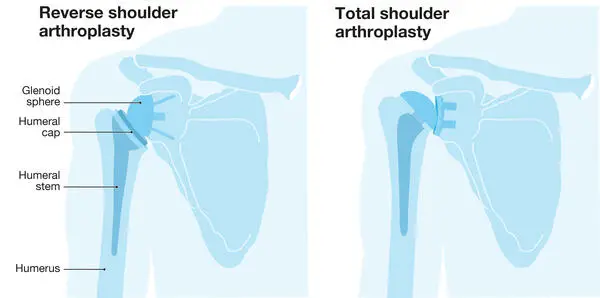
10 Signs You Need a Shoulder Joint Replacement
Shoulder pain can make even simple activities like reaching for a cup or combing your hair feel like a monumental task. While conservative treatments such as physical therapy, anti-inflammatory medications, and cortisone injections often provide relief, there are times when these nonsurgical treatments are no longer effective.
If you’re experiencing persistent discomfort or limitations in motion, it might be time to consider shoulder surgery. Here are the key signs that you may need a shoulder joint replacement.
1. Severe Pain That Doesn’t Improve
One of the most common reasons people seek shoulder surgery is severe shoulder pain that doesn’t respond to conservative treatments. Whether the pain stems from rotator cuff tears, inflammatory arthritis, or avascular necrosis, it can become debilitating. If over-the-counter pain medications, nonpharmacologic pain management, activity modification, or physical therapy exercises no longer provide relief, consult an orthopedic surgeon about surgical options.
2. Loss of Range of Motion
The shoulder is a ball-and-socket joint, where the humeral head (the ball) fits into the glenoid bone (the socket). Conditions like primary osteoarthritis, rheumatoid arthritis, or cuff tear arthropathy can damage the joint surfaces, causing stiffness and a limited range of motion. If you struggle to perform overhead motions or find your shoulder mobility severely restricted, a shoulder replacement surgery might be the best solution to restore function.
3. Chronic Shoulder Pain at Rest
While pain during physical activity is shared with shoulder conditions, chronic pain, even at rest, is a red flag. This could indicate advanced joint damage or severe arthritis. If your pain disrupts your sleep or makes it difficult to perform daily activities, it’s worth exploring shoulder replacement options with your care team.
4. Failed Nonsurgical Treatments
If you’ve tried physical therapy, biologic injections, or activity modification without success, surgical intervention may be the next step. Orthopedic surgeons often recommend shoulder replacement surgery when nonsurgical treatments fail to provide the degree of pain relief needed to maintain a healthy lifestyle.
5. Imaging Tests Reveal Significant Damage
A shoulder X-ray or CT imaging can reveal the extent of damage to your shoulder bones, rotator cuff tendons, or joint surfaces. Conditions like severe rotator cuff tears, traumatic injury, or advanced osteoarthritis may necessitate a shoulder arthroplasty. Then, your surgeon may recommend a traditional shoulder replacement, reverse shoulder replacement, or partial shoulder replacement.
6. Difficulty Performing Everyday Activities
If your shoulder condition makes it hard to perform simple activities like dressing, cooking, or driving, it’s a sign that your shoulder function is severely compromised. Shoulder replacement procedures can help restore your ability to engage in light activity and improve your quality of life.
7. Severe Shoulder Fractures or Trauma
In severe shoulder fractures or trauma, the humeral head or glenoid bone may be irreparably damaged. Shoulder replacement implants, such as prosthetics, such as prosthetic balls or artificial socket replacements, replace damaged components and restore joint function.
8. Rotator Cuff Injury or Tears
For those suffering from rotator cuff tears or injuries, a reverse shoulder replacement often emerges as the optimal solution. This is especially beneficial for patients with cuff tear arthropathy, as it restructures the shoulder’s mechanics to work around the compromised rotator cuff muscles, improving function and reducing pain.
9. Nerve Damage or Blood Flow Issues
Conditions such as avascular necrosis or nerve damage can disrupt the blood flow to the humeral head, resulting in bone deterioration. In these situations, shoulder replacement surgery can replace the affected bone with an artificial joint, restoring mobility and providing significant pain relief.
10. You’re an Active Person Seeking Long-Term Relief
For active patients or those with a high activity level, living with chronic shoulder pain or severe limitations is not sustainable. Shoulder replacement surgery offers a chance to regain shoulder strength and return to an active lifestyle.
If you identify with any of these signs, don’t wait to seek professional advice—early intervention can help you regain mobility, reduce pain, and improve your quality of life.
Types of Shoulder Replacement Surgery
There are several shoulder replacement approaches, including:
- Anatomic shoulder replacements: Replace the damaged humeral head and glenoid bone with prosthetic implants.
- Reverse shoulder replacement: Ideal for patients with severe rotator cuff tears, this procedure places the metal ball on the shoulder blade and the plastic socket on the arm bone.
- Partial shoulder replacement: In this procedure, only the humeral head is replaced, preserving the natural glenoid bone.
Your orthopedic surgeon will assess your shoulder condition, medical history, and activity level to determine the ideal shoulder replacement option. This will help you achieve optimal shoulder function and long-term pain relief.
Recovery and Life After Shoulder Replacement
Recovery time varies, but most patients begin physical therapy exercises within days after surgery. While heavy lifting should be avoided for several weeks after surgery, most people experience a faster recovery and significant improvement in shoulder mobility.
Conclusion
If you’re experiencing severe shoulder pain, loss of motion, or difficulty performing daily activities, it may be time to consider shoulder replacement surgery. Speak with an orthopedic surgeon to discuss your treatment possibilities and identify the most suitable shoulder replacement option for your specific condition. With advancements in shoulder implants and surgical techniques, thousands of patients have regained their shoulder function and returned to an active, pain-free life.